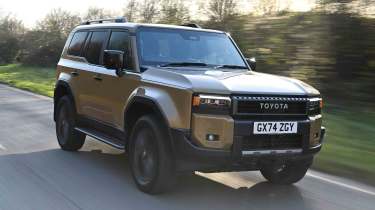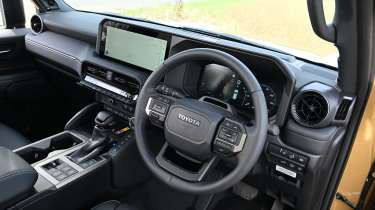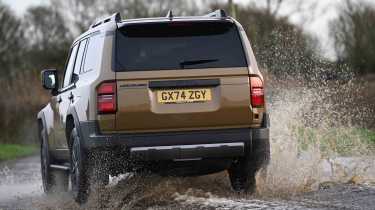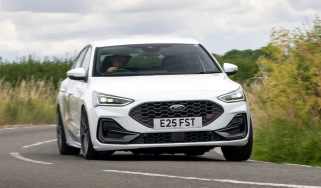Toyota Land Cruiser review – is it worth £15k more than a Defender?
The new Land Cruiser promises to be better than ever on and off the beaten track, and has Land Rover’s Defender firmly in its sights – we put it to the test
The evo office car park is often littered with attention-grabbing metal, whether it be the M5 Touring or Defender Octa from our long-term fleet, or something with an ankle-high splitter and fluro paintwork we’ve booked in to test. Where does the new Toyota Land Cruiser fit in that league? When it comes to drawing eyeballs, somewhere near the top of the list. Yes, really. I can’t remember the last time I lived with a car that generated so much interest and sparked so much conversation. It has a magnetic presence. On the road you notice the odd second glance, but park up and people stop in their tracks, take in the retro details and smudge their noses against the glass for a look at the interior. ‘What is it? How much is it? Can I sit inside?’ is the general trend of conversation. It seems in its latest generation, Toyota’s rough and tumble workhorse has become something of a superstar.
So, design nailed. But the Land Cruiser faces much bigger challenges than that. Mastering harsh environments around the world where its predecessors thrive, for one, but also beating the Land Rover Defender – a car with an impressively rounded set of abilities having been totally reimagined at the turn of the decade. Oh, and it needs to be a complete package to justify a near-£80k base price, because at that level, customers expect more than a single-minded farmyard tool. For now our time with the Land Cruiser has been exclusively on the road – where owners will surely use them most – but we’re sympathetic to its broader brief as an impregnable off-roader.
For this latest model, Toyota recognises the need to expand the Land Cruiser’s repertoire, promising a leap forward in on-road dynamics while prioritising toughness and off-road ability at its core. To that end it rides on a new GA-F platform and retains a body-on-frame structure, which is stiffer than before with more extensive body sealing and sound-proofing to improve refinement. Suspension is by double wishbones at the front with an electronic roll bar decoupling system to improve wheel articulation, and a four-link solid axle at the rear.
Toyota has used rack-and-pinion steering rather than a recirculating ball system, with electric power assistance tuned to reduce kickback. In terms of off-road vs on-road bias, the mechanical layout is somewhere between the more workmanlike Ineos Grenadier and the Defender, which uses a unibody construction with independent suspension front and rear.
Push the start button and the Land Cruiser grumbles into life a bit like an old Transit would. That’s the 2.8-diesel engine chugging away, the only engine currently available (although deliveries of a mild-hybrid variant will commence early next year). It produces 202bhp, a slim figure given there’s 2335kg to shift along, although torque is much healthier at 369lb ft. It’s linked up to an eight-speed automatic gearbox with high and low range and an electronic locking rear diff, operated with controls on the centre console.
The Land Cruiser feels huge from behind the wheel. You’re perched much higher than most conventional SUVs and it seems like the tailgate is yards behind you, but the boxiness of the design (and the 360 degree camera system) means it’s not too difficult to judge the extremes of the car. The cabin is very much function-first – blocky, robust and substantial, with very little design frippery. With that said, there are enough softly padded surfaces to avoid it feeling cheap and it’s well appointed for tech, with a 12.3-inch digital dash coupled with a central touchscreen of the same size. It’s the same infotainment system you’ll find in other Toyotas and far from the most advanced on the market, but the screen resolution is crisp and the software is easy enough to navigate. Our First Edition test car was packed with kit, including a punchy JBL sound system, a sunroof, front and rear climate controls, a head up display and an air-conditioned coolbox in the centre console.
Within just a few miles you sense that the Land Cruiser’s natural stomping ground is off road rather than on it, but it’s far from as compromised as something like a Grenadier, and more palatable in daily use as a result. The steering is slow with weak self centring, but the front end follows your commands somewhat faithfully, and it doesn’t need constant adjustment to stay on course. The body is free to bob and lurch on its springs but as long as you’re calm and patient it isn't worryingly lacking in control. You definitely can’t approach it like more car-like SUVs, but it’s not a wandering mess like some of its more overtly utilitarian rivals (cough, the Grenadier).
With that said, there is a gap to the Defender in terms of refinement and finesse on tarmac. The engine, for one, is well off the pace. It strains and struggles against the Land Cruiser’s mass under mild acceleration, and the transmission is forced to hold onto gears and keep the revs up to make any meaningful progress. It’s better when holding a constant speed, the groan fading to a hum, but the car is crying out for a gutsier engine to go with the sense of unstoppable strength that otherwise permeates through it. A jittery, jumpy low speed ride hurts it against the Land Rover too. Given the meaty sidewalls of the Dunlop Grandtrek tyres you might expect it to steamroll the surface, but imperfections thud firmly through the structure and the rear has the characteristic bobble of a solid axle setup on uneven ground. It’s better at a cruise, however, and you can cover big miles quite happily – so long as you turn up that JBL system to drown out the wind noise.
Testing the Land Cruiser’s handling feels like judging a Caterham’s ability to drive up a mud track, but corners do exist, and the Defender proves that a well-engineered off-roader can take them neatly. For this type of car the Land Cruiser is adequate, nothing more. It lumbers along faithfully, and as long as you give it time to lean over and settle, there are no nasty surprises. It rolls heavily, the front Dunlops bleed away grip quite quickly and plenty of arm twirling is needed, but none of that renders it a complete chore to thread along.
You won’t find the thrill of driving here (not even a scrap), but the Land Cruiser is charming in its own way. It’s what Ineos should have aimed for with the Grenadier – undeniably robust and off-road focused in its mechanical make-up, but not enough that the on-road driving experience suffers so badly. But the Defender is still a tough nut to crack. I’m sure a case can be made for the Toyota’s durability and off-road prowess, but the Land Rover is the slicker family car, still capable off the beaten track and a huge chunk more affordable – the base 110 is £62,795, and you can get the X-Dynamic HSE with a 345bhp six-cylinder diesel for less than £80k. With a better engine and a lower asking price the Land Cruiser would be a much easier sell.







